Business Law Report: Sources of Law, Business Organizations, Disputes
VerifiedAdded on 2023/01/12
|20
|6374
|52
Report
AI Summary
This report provides a comprehensive overview of business law in the UK, examining the sources of law, including equity law, common law, and European Union law, and the role of government in the law-making process. It explores the impact of company, employment, and contract law on businesses, using specific examples to illustrate key concepts like the doctrine of incorporation, employment contracts, and the distinction between employees and self-employed individuals. The report also delves into different types of business organizations, their legal formation, funding, and management, along with their respective advantages and disadvantages. Furthermore, it addresses legal solutions for resolving business disputes, comparing and contrasting various sources of legal advice and support, and evaluating the effectiveness of these solutions. The assignment offers a thorough analysis of the UK legal system and its practical implications for businesses, providing valuable insights into legal compliance and dispute resolution strategies.

BUSINESS LAW
Paraphrase This Document
Need a fresh take? Get an instant paraphrase of this document with our AI Paraphraser
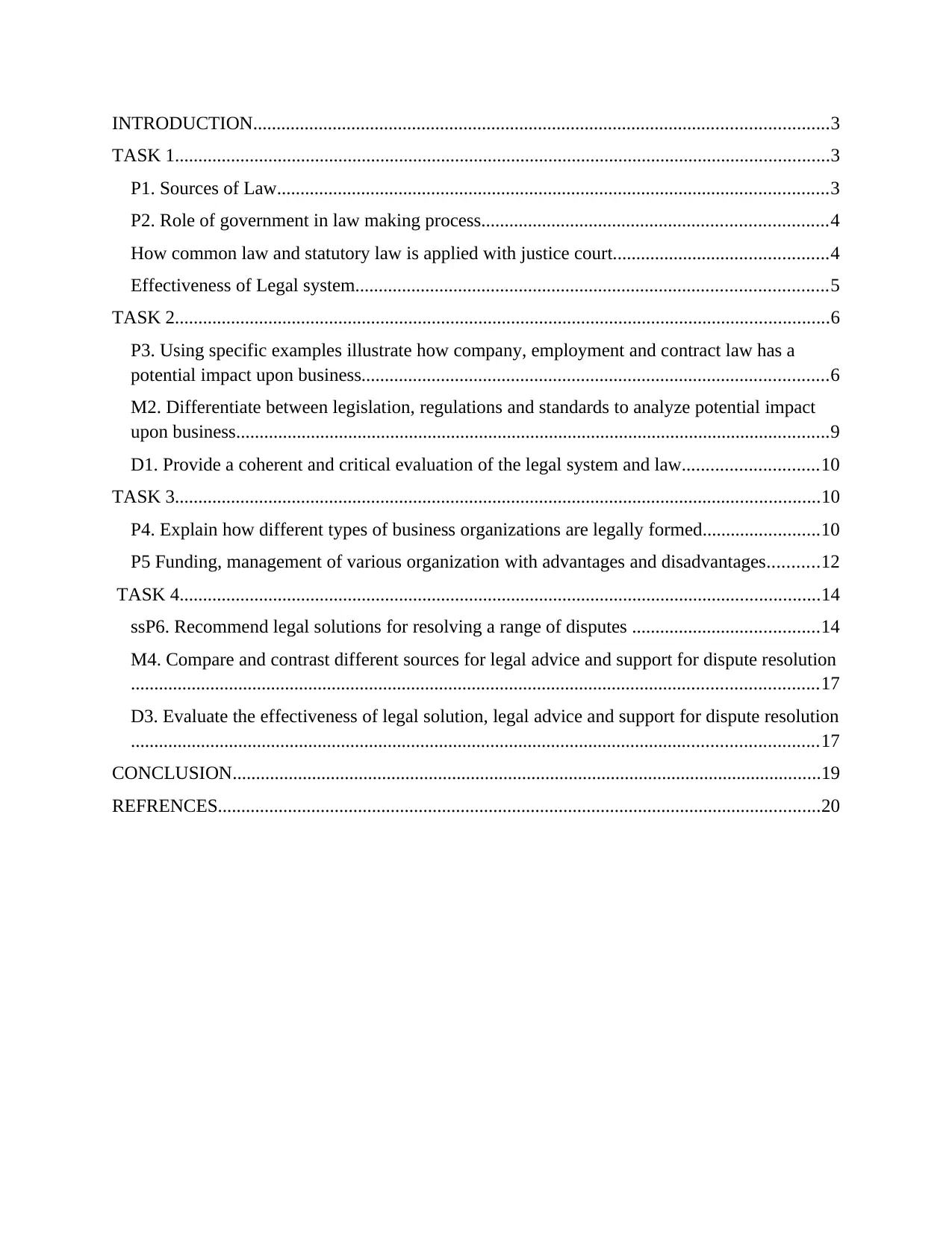
INTRODUCTION...........................................................................................................................3
TASK 1............................................................................................................................................3
P1. Sources of Law......................................................................................................................3
P2. Role of government in law making process..........................................................................4
How common law and statutory law is applied with justice court..............................................4
Effectiveness of Legal system.....................................................................................................5
TASK 2............................................................................................................................................6
P3. Using specific examples illustrate how company, employment and contract law has a
potential impact upon business....................................................................................................6
M2. Differentiate between legislation, regulations and standards to analyze potential impact
upon business...............................................................................................................................9
D1. Provide a coherent and critical evaluation of the legal system and law.............................10
TASK 3..........................................................................................................................................10
P4. Explain how different types of business organizations are legally formed.........................10
P5 Funding, management of various organization with advantages and disadvantages...........12
TASK 4.........................................................................................................................................14
ssP6. Recommend legal solutions for resolving a range of disputes ........................................14
M4. Compare and contrast different sources for legal advice and support for dispute resolution
...................................................................................................................................................17
D3. Evaluate the effectiveness of legal solution, legal advice and support for dispute resolution
...................................................................................................................................................17
CONCLUSION..............................................................................................................................19
REFRENCES.................................................................................................................................20
TASK 1............................................................................................................................................3
P1. Sources of Law......................................................................................................................3
P2. Role of government in law making process..........................................................................4
How common law and statutory law is applied with justice court..............................................4
Effectiveness of Legal system.....................................................................................................5
TASK 2............................................................................................................................................6
P3. Using specific examples illustrate how company, employment and contract law has a
potential impact upon business....................................................................................................6
M2. Differentiate between legislation, regulations and standards to analyze potential impact
upon business...............................................................................................................................9
D1. Provide a coherent and critical evaluation of the legal system and law.............................10
TASK 3..........................................................................................................................................10
P4. Explain how different types of business organizations are legally formed.........................10
P5 Funding, management of various organization with advantages and disadvantages...........12
TASK 4.........................................................................................................................................14
ssP6. Recommend legal solutions for resolving a range of disputes ........................................14
M4. Compare and contrast different sources for legal advice and support for dispute resolution
...................................................................................................................................................17
D3. Evaluate the effectiveness of legal solution, legal advice and support for dispute resolution
...................................................................................................................................................17
CONCLUSION..............................................................................................................................19
REFRENCES.................................................................................................................................20
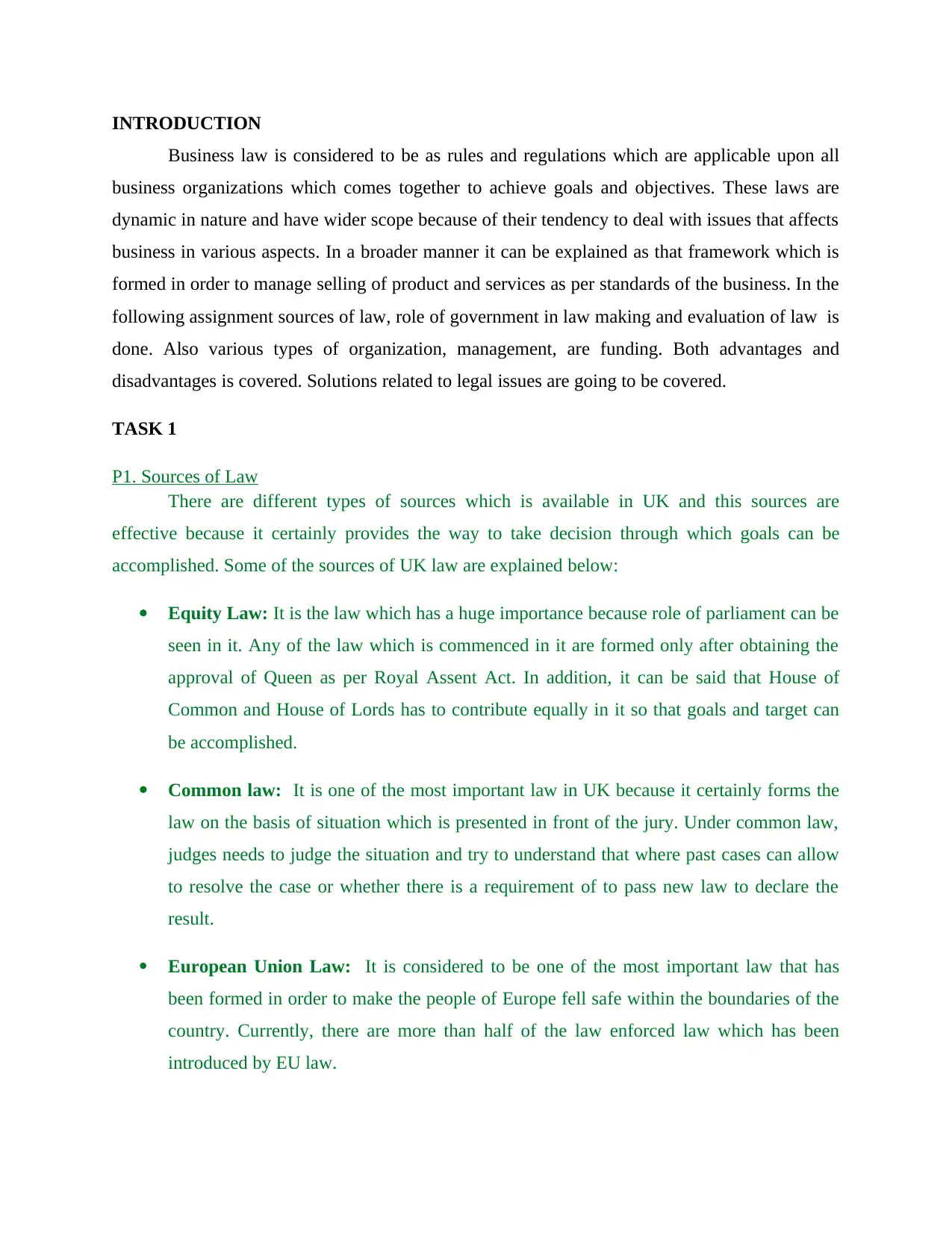
INTRODUCTION
Business law is considered to be as rules and regulations which are applicable upon all
business organizations which comes together to achieve goals and objectives. These laws are
dynamic in nature and have wider scope because of their tendency to deal with issues that affects
business in various aspects. In a broader manner it can be explained as that framework which is
formed in order to manage selling of product and services as per standards of the business. In the
following assignment sources of law, role of government in law making and evaluation of law is
done. Also various types of organization, management, are funding. Both advantages and
disadvantages is covered. Solutions related to legal issues are going to be covered.
TASK 1
P1. Sources of Law
There are different types of sources which is available in UK and this sources are
effective because it certainly provides the way to take decision through which goals can be
accomplished. Some of the sources of UK law are explained below:
Equity Law: It is the law which has a huge importance because role of parliament can be
seen in it. Any of the law which is commenced in it are formed only after obtaining the
approval of Queen as per Royal Assent Act. In addition, it can be said that House of
Common and House of Lords has to contribute equally in it so that goals and target can
be accomplished.
Common law: It is one of the most important law in UK because it certainly forms the
law on the basis of situation which is presented in front of the jury. Under common law,
judges needs to judge the situation and try to understand that where past cases can allow
to resolve the case or whether there is a requirement of to pass new law to declare the
result.
European Union Law: It is considered to be one of the most important law that has
been formed in order to make the people of Europe fell safe within the boundaries of the
country. Currently, there are more than half of the law enforced law which has been
introduced by EU law.
Business law is considered to be as rules and regulations which are applicable upon all
business organizations which comes together to achieve goals and objectives. These laws are
dynamic in nature and have wider scope because of their tendency to deal with issues that affects
business in various aspects. In a broader manner it can be explained as that framework which is
formed in order to manage selling of product and services as per standards of the business. In the
following assignment sources of law, role of government in law making and evaluation of law is
done. Also various types of organization, management, are funding. Both advantages and
disadvantages is covered. Solutions related to legal issues are going to be covered.
TASK 1
P1. Sources of Law
There are different types of sources which is available in UK and this sources are
effective because it certainly provides the way to take decision through which goals can be
accomplished. Some of the sources of UK law are explained below:
Equity Law: It is the law which has a huge importance because role of parliament can be
seen in it. Any of the law which is commenced in it are formed only after obtaining the
approval of Queen as per Royal Assent Act. In addition, it can be said that House of
Common and House of Lords has to contribute equally in it so that goals and target can
be accomplished.
Common law: It is one of the most important law in UK because it certainly forms the
law on the basis of situation which is presented in front of the jury. Under common law,
judges needs to judge the situation and try to understand that where past cases can allow
to resolve the case or whether there is a requirement of to pass new law to declare the
result.
European Union Law: It is considered to be one of the most important law that has
been formed in order to make the people of Europe fell safe within the boundaries of the
country. Currently, there are more than half of the law enforced law which has been
introduced by EU law.
⊘ This is a preview!⊘
Do you want full access?
Subscribe today to unlock all pages.

Trusted by 1+ million students worldwide
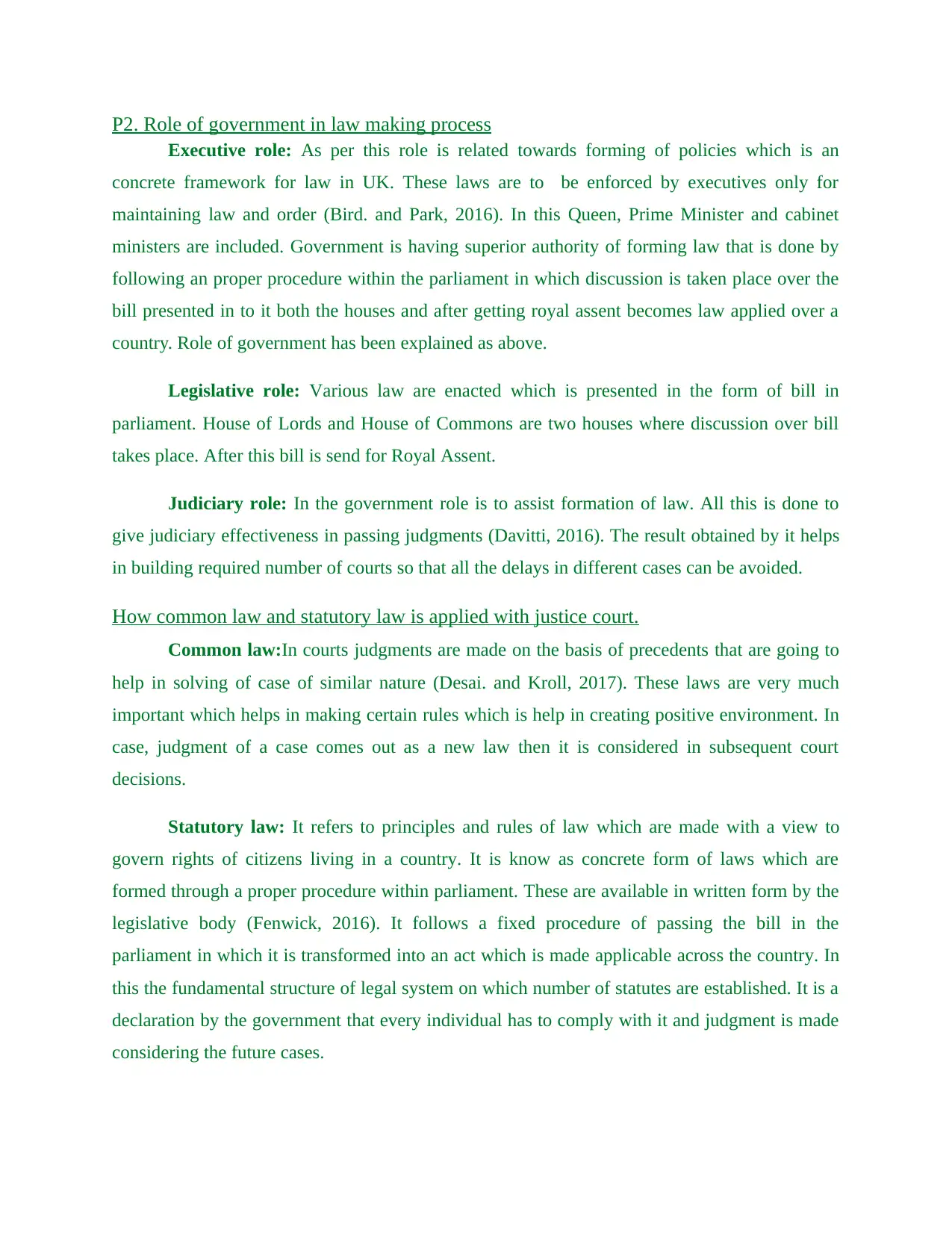
P2. Role of government in law making process
Executive role: As per this role is related towards forming of policies which is an
concrete framework for law in UK. These laws are to be enforced by executives only for
maintaining law and order (Bird. and Park, 2016). In this Queen, Prime Minister and cabinet
ministers are included. Government is having superior authority of forming law that is done by
following an proper procedure within the parliament in which discussion is taken place over the
bill presented in to it both the houses and after getting royal assent becomes law applied over a
country. Role of government has been explained as above.
Legislative role: Various law are enacted which is presented in the form of bill in
parliament. House of Lords and House of Commons are two houses where discussion over bill
takes place. After this bill is send for Royal Assent.
Judiciary role: In the government role is to assist formation of law. All this is done to
give judiciary effectiveness in passing judgments (Davitti, 2016). The result obtained by it helps
in building required number of courts so that all the delays in different cases can be avoided.
How common law and statutory law is applied with justice court.
Common law:In courts judgments are made on the basis of precedents that are going to
help in solving of case of similar nature (Desai. and Kroll, 2017). These laws are very much
important which helps in making certain rules which is help in creating positive environment. In
case, judgment of a case comes out as a new law then it is considered in subsequent court
decisions.
Statutory law: It refers to principles and rules of law which are made with a view to
govern rights of citizens living in a country. It is know as concrete form of laws which are
formed through a proper procedure within parliament. These are available in written form by the
legislative body (Fenwick, 2016). It follows a fixed procedure of passing the bill in the
parliament in which it is transformed into an act which is made applicable across the country. In
this the fundamental structure of legal system on which number of statutes are established. It is a
declaration by the government that every individual has to comply with it and judgment is made
considering the future cases.
Executive role: As per this role is related towards forming of policies which is an
concrete framework for law in UK. These laws are to be enforced by executives only for
maintaining law and order (Bird. and Park, 2016). In this Queen, Prime Minister and cabinet
ministers are included. Government is having superior authority of forming law that is done by
following an proper procedure within the parliament in which discussion is taken place over the
bill presented in to it both the houses and after getting royal assent becomes law applied over a
country. Role of government has been explained as above.
Legislative role: Various law are enacted which is presented in the form of bill in
parliament. House of Lords and House of Commons are two houses where discussion over bill
takes place. After this bill is send for Royal Assent.
Judiciary role: In the government role is to assist formation of law. All this is done to
give judiciary effectiveness in passing judgments (Davitti, 2016). The result obtained by it helps
in building required number of courts so that all the delays in different cases can be avoided.
How common law and statutory law is applied with justice court.
Common law:In courts judgments are made on the basis of precedents that are going to
help in solving of case of similar nature (Desai. and Kroll, 2017). These laws are very much
important which helps in making certain rules which is help in creating positive environment. In
case, judgment of a case comes out as a new law then it is considered in subsequent court
decisions.
Statutory law: It refers to principles and rules of law which are made with a view to
govern rights of citizens living in a country. It is know as concrete form of laws which are
formed through a proper procedure within parliament. These are available in written form by the
legislative body (Fenwick, 2016). It follows a fixed procedure of passing the bill in the
parliament in which it is transformed into an act which is made applicable across the country. In
this the fundamental structure of legal system on which number of statutes are established. It is a
declaration by the government that every individual has to comply with it and judgment is made
considering the future cases.
Paraphrase This Document
Need a fresh take? Get an instant paraphrase of this document with our AI Paraphraser

Effectiveness of Legal system
Legal system in UK has gone through lot of changes from time to time which has resulted
into its development. Despite of developing itself still many loopholes are there which are
existing in its legal system. Existing system of law in UK is very much difficult to understand
because of its complex structure. This has made it less developed then other modern countries.
Different parts are there in UK legal system which ahs made coordination very difficult among
legal personal and laws. Modernization has not been done which makes it not compatible with
Legal system in UK has gone through lot of changes from time to time which has resulted
into its development. Despite of developing itself still many loopholes are there which are
existing in its legal system. Existing system of law in UK is very much difficult to understand
because of its complex structure. This has made it less developed then other modern countries.
Different parts are there in UK legal system which ahs made coordination very difficult among
legal personal and laws. Modernization has not been done which makes it not compatible with
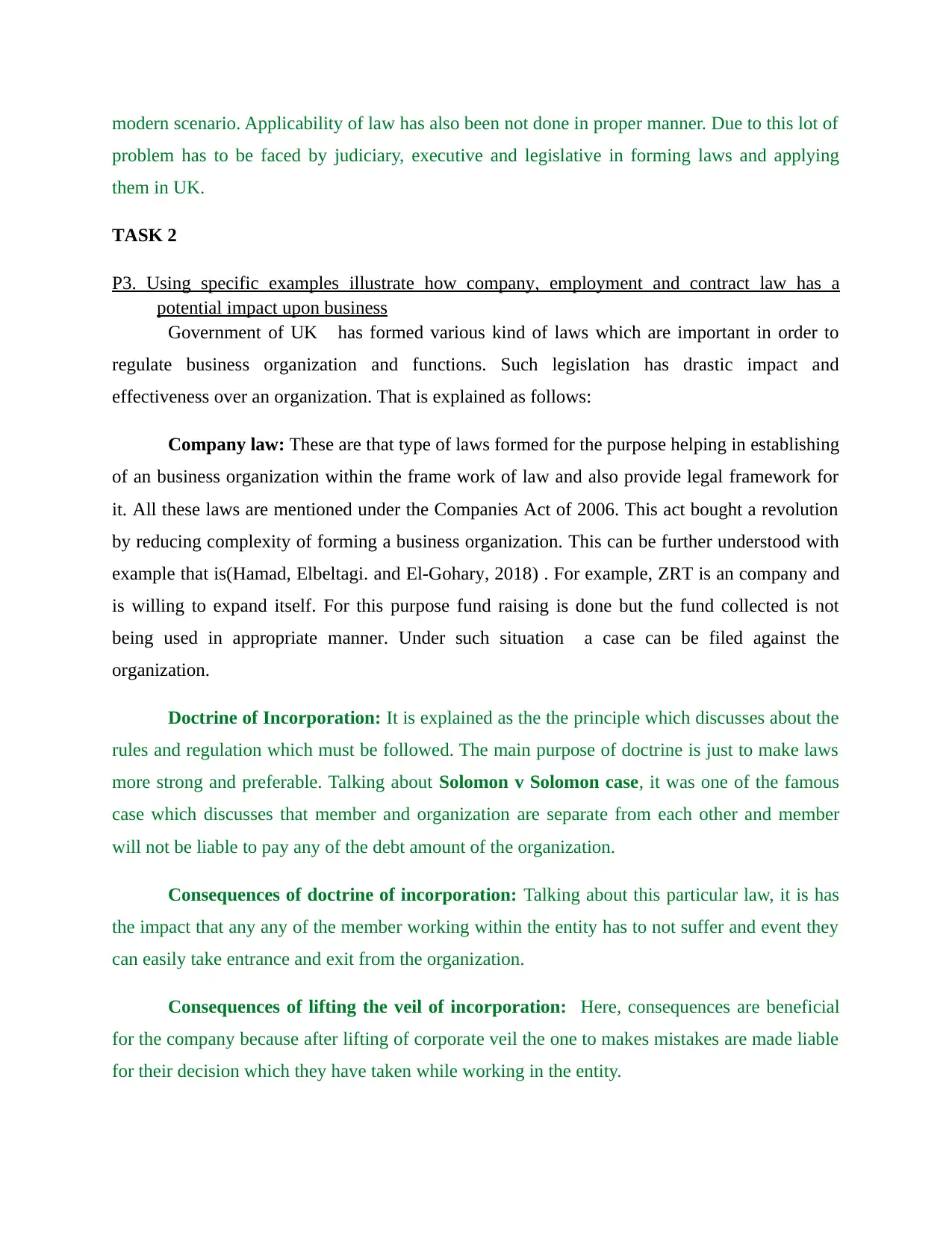
modern scenario. Applicability of law has also been not done in proper manner. Due to this lot of
problem has to be faced by judiciary, executive and legislative in forming laws and applying
them in UK.
TASK 2
P3. Using specific examples illustrate how company, employment and contract law has a
potential impact upon business
Government of UK has formed various kind of laws which are important in order to
regulate business organization and functions. Such legislation has drastic impact and
effectiveness over an organization. That is explained as follows:
Company law: These are that type of laws formed for the purpose helping in establishing
of an business organization within the frame work of law and also provide legal framework for
it. All these laws are mentioned under the Companies Act of 2006. This act bought a revolution
by reducing complexity of forming a business organization. This can be further understood with
example that is(Hamad, Elbeltagi. and El‐Gohary, 2018) . For example, ZRT is an company and
is willing to expand itself. For this purpose fund raising is done but the fund collected is not
being used in appropriate manner. Under such situation a case can be filed against the
organization.
Doctrine of Incorporation: It is explained as the the principle which discusses about the
rules and regulation which must be followed. The main purpose of doctrine is just to make laws
more strong and preferable. Talking about Solomon v Solomon case, it was one of the famous
case which discusses that member and organization are separate from each other and member
will not be liable to pay any of the debt amount of the organization.
Consequences of doctrine of incorporation: Talking about this particular law, it is has
the impact that any any of the member working within the entity has to not suffer and event they
can easily take entrance and exit from the organization.
Consequences of lifting the veil of incorporation: Here, consequences are beneficial
for the company because after lifting of corporate veil the one to makes mistakes are made liable
for their decision which they have taken while working in the entity.
problem has to be faced by judiciary, executive and legislative in forming laws and applying
them in UK.
TASK 2
P3. Using specific examples illustrate how company, employment and contract law has a
potential impact upon business
Government of UK has formed various kind of laws which are important in order to
regulate business organization and functions. Such legislation has drastic impact and
effectiveness over an organization. That is explained as follows:
Company law: These are that type of laws formed for the purpose helping in establishing
of an business organization within the frame work of law and also provide legal framework for
it. All these laws are mentioned under the Companies Act of 2006. This act bought a revolution
by reducing complexity of forming a business organization. This can be further understood with
example that is(Hamad, Elbeltagi. and El‐Gohary, 2018) . For example, ZRT is an company and
is willing to expand itself. For this purpose fund raising is done but the fund collected is not
being used in appropriate manner. Under such situation a case can be filed against the
organization.
Doctrine of Incorporation: It is explained as the the principle which discusses about the
rules and regulation which must be followed. The main purpose of doctrine is just to make laws
more strong and preferable. Talking about Solomon v Solomon case, it was one of the famous
case which discusses that member and organization are separate from each other and member
will not be liable to pay any of the debt amount of the organization.
Consequences of doctrine of incorporation: Talking about this particular law, it is has
the impact that any any of the member working within the entity has to not suffer and event they
can easily take entrance and exit from the organization.
Consequences of lifting the veil of incorporation: Here, consequences are beneficial
for the company because after lifting of corporate veil the one to makes mistakes are made liable
for their decision which they have taken while working in the entity.
⊘ This is a preview!⊘
Do you want full access?
Subscribe today to unlock all pages.

Trusted by 1+ million students worldwide
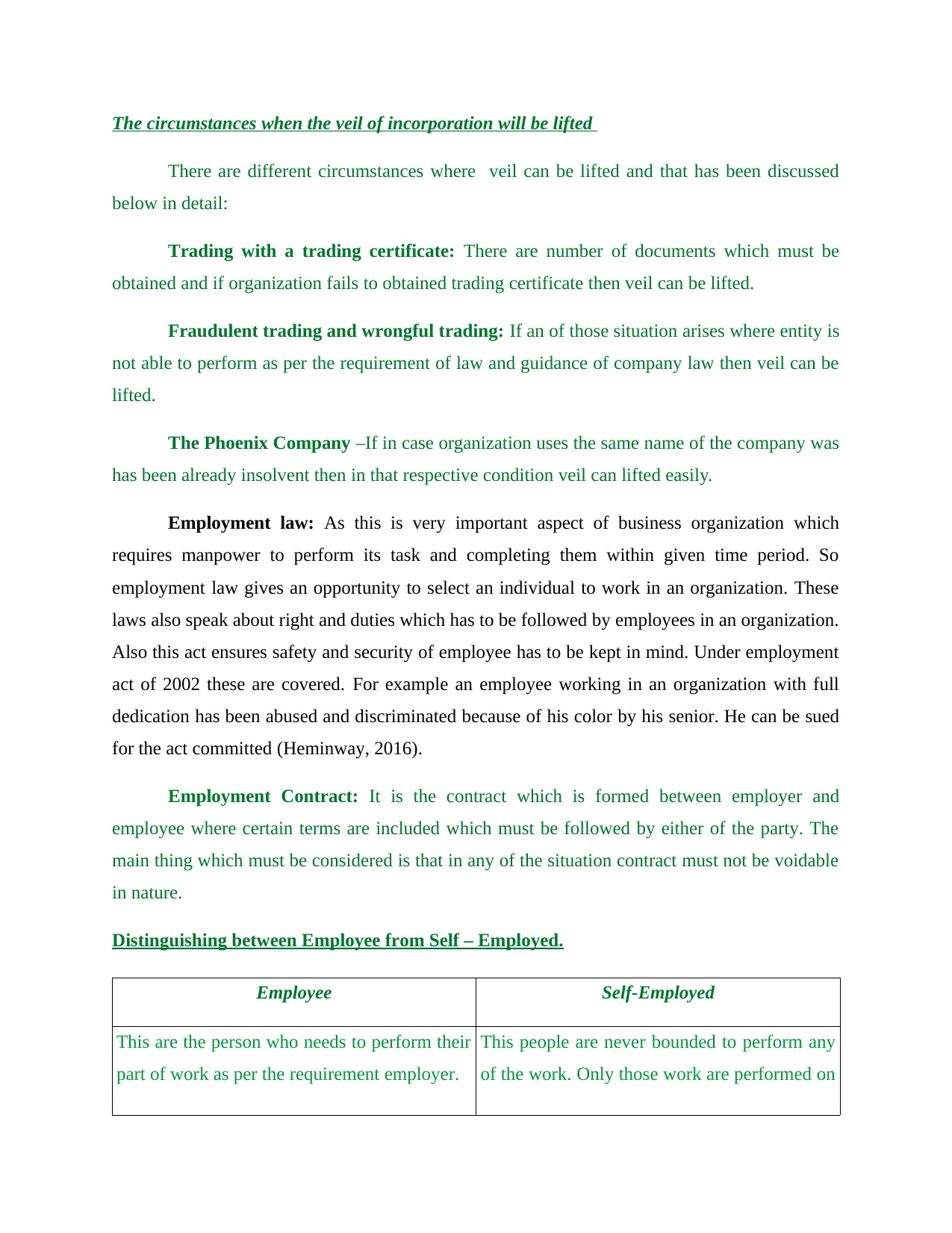
The circumstances when the veil of incorporation will be lifted
There are different circumstances where veil can be lifted and that has been discussed
below in detail:
Trading with a trading certificate: There are number of documents which must be
obtained and if organization fails to obtained trading certificate then veil can be lifted.
Fraudulent trading and wrongful trading: If an of those situation arises where entity is
not able to perform as per the requirement of law and guidance of company law then veil can be
lifted.
The Phoenix Company –If in case organization uses the same name of the company was
has been already insolvent then in that respective condition veil can lifted easily.
Employment law: As this is very important aspect of business organization which
requires manpower to perform its task and completing them within given time period. So
employment law gives an opportunity to select an individual to work in an organization. These
laws also speak about right and duties which has to be followed by employees in an organization.
Also this act ensures safety and security of employee has to be kept in mind. Under employment
act of 2002 these are covered. For example an employee working in an organization with full
dedication has been abused and discriminated because of his color by his senior. He can be sued
for the act committed (Heminway, 2016).
Employment Contract: It is the contract which is formed between employer and
employee where certain terms are included which must be followed by either of the party. The
main thing which must be considered is that in any of the situation contract must not be voidable
in nature.
Distinguishing between Employee from Self – Employed.
Employee Self-Employed
This are the person who needs to perform their
part of work as per the requirement employer.
This people are never bounded to perform any
of the work. Only those work are performed on
There are different circumstances where veil can be lifted and that has been discussed
below in detail:
Trading with a trading certificate: There are number of documents which must be
obtained and if organization fails to obtained trading certificate then veil can be lifted.
Fraudulent trading and wrongful trading: If an of those situation arises where entity is
not able to perform as per the requirement of law and guidance of company law then veil can be
lifted.
The Phoenix Company –If in case organization uses the same name of the company was
has been already insolvent then in that respective condition veil can lifted easily.
Employment law: As this is very important aspect of business organization which
requires manpower to perform its task and completing them within given time period. So
employment law gives an opportunity to select an individual to work in an organization. These
laws also speak about right and duties which has to be followed by employees in an organization.
Also this act ensures safety and security of employee has to be kept in mind. Under employment
act of 2002 these are covered. For example an employee working in an organization with full
dedication has been abused and discriminated because of his color by his senior. He can be sued
for the act committed (Heminway, 2016).
Employment Contract: It is the contract which is formed between employer and
employee where certain terms are included which must be followed by either of the party. The
main thing which must be considered is that in any of the situation contract must not be voidable
in nature.
Distinguishing between Employee from Self – Employed.
Employee Self-Employed
This are the person who needs to perform their
part of work as per the requirement employer.
This people are never bounded to perform any
of the work. Only those work are performed on
Paraphrase This Document
Need a fresh take? Get an instant paraphrase of this document with our AI Paraphraser
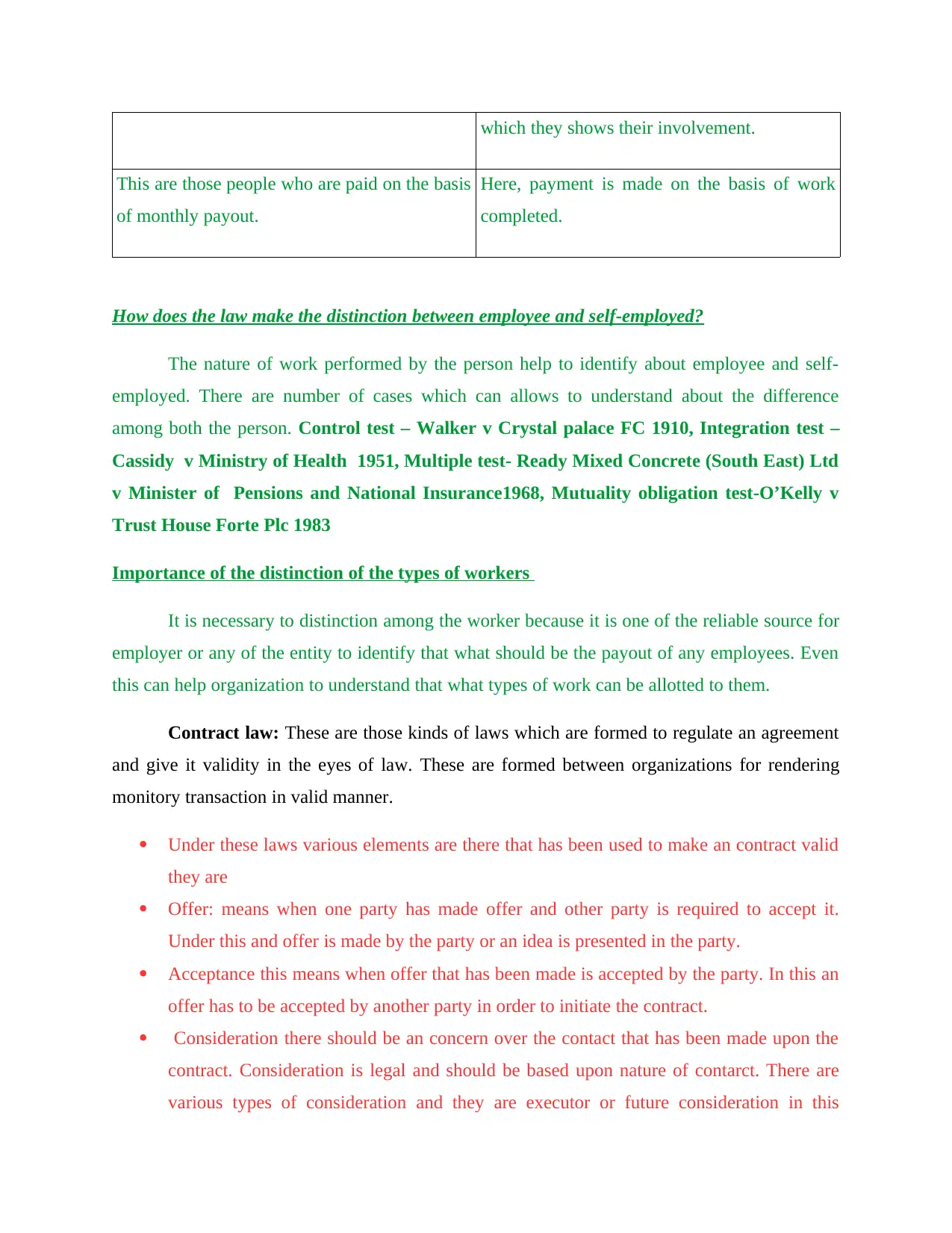
which they shows their involvement.
This are those people who are paid on the basis
of monthly payout.
Here, payment is made on the basis of work
completed.
How does the law make the distinction between employee and self-employed?
The nature of work performed by the person help to identify about employee and self-
employed. There are number of cases which can allows to understand about the difference
among both the person. Control test – Walker v Crystal palace FC 1910, Integration test –
Cassidy v Ministry of Health 1951, Multiple test- Ready Mixed Concrete (South East) Ltd
v Minister of Pensions and National Insurance1968, Mutuality obligation test-O’Kelly v
Trust House Forte Plc 1983
Importance of the distinction of the types of workers
It is necessary to distinction among the worker because it is one of the reliable source for
employer or any of the entity to identify that what should be the payout of any employees. Even
this can help organization to understand that what types of work can be allotted to them.
Contract law: These are those kinds of laws which are formed to regulate an agreement
and give it validity in the eyes of law. These are formed between organizations for rendering
monitory transaction in valid manner.
Under these laws various elements are there that has been used to make an contract valid
they are
Offer: means when one party has made offer and other party is required to accept it.
Under this and offer is made by the party or an idea is presented in the party.
Acceptance this means when offer that has been made is accepted by the party. In this an
offer has to be accepted by another party in order to initiate the contract.
Consideration there should be an concern over the contact that has been made upon the
contract. Consideration is legal and should be based upon nature of contarct. There are
various types of consideration and they are executor or future consideration in this
This are those people who are paid on the basis
of monthly payout.
Here, payment is made on the basis of work
completed.
How does the law make the distinction between employee and self-employed?
The nature of work performed by the person help to identify about employee and self-
employed. There are number of cases which can allows to understand about the difference
among both the person. Control test – Walker v Crystal palace FC 1910, Integration test –
Cassidy v Ministry of Health 1951, Multiple test- Ready Mixed Concrete (South East) Ltd
v Minister of Pensions and National Insurance1968, Mutuality obligation test-O’Kelly v
Trust House Forte Plc 1983
Importance of the distinction of the types of workers
It is necessary to distinction among the worker because it is one of the reliable source for
employer or any of the entity to identify that what should be the payout of any employees. Even
this can help organization to understand that what types of work can be allotted to them.
Contract law: These are those kinds of laws which are formed to regulate an agreement
and give it validity in the eyes of law. These are formed between organizations for rendering
monitory transaction in valid manner.
Under these laws various elements are there that has been used to make an contract valid
they are
Offer: means when one party has made offer and other party is required to accept it.
Under this and offer is made by the party or an idea is presented in the party.
Acceptance this means when offer that has been made is accepted by the party. In this an
offer has to be accepted by another party in order to initiate the contract.
Consideration there should be an concern over the contact that has been made upon the
contract. Consideration is legal and should be based upon nature of contarct. There are
various types of consideration and they are executor or future consideration in this
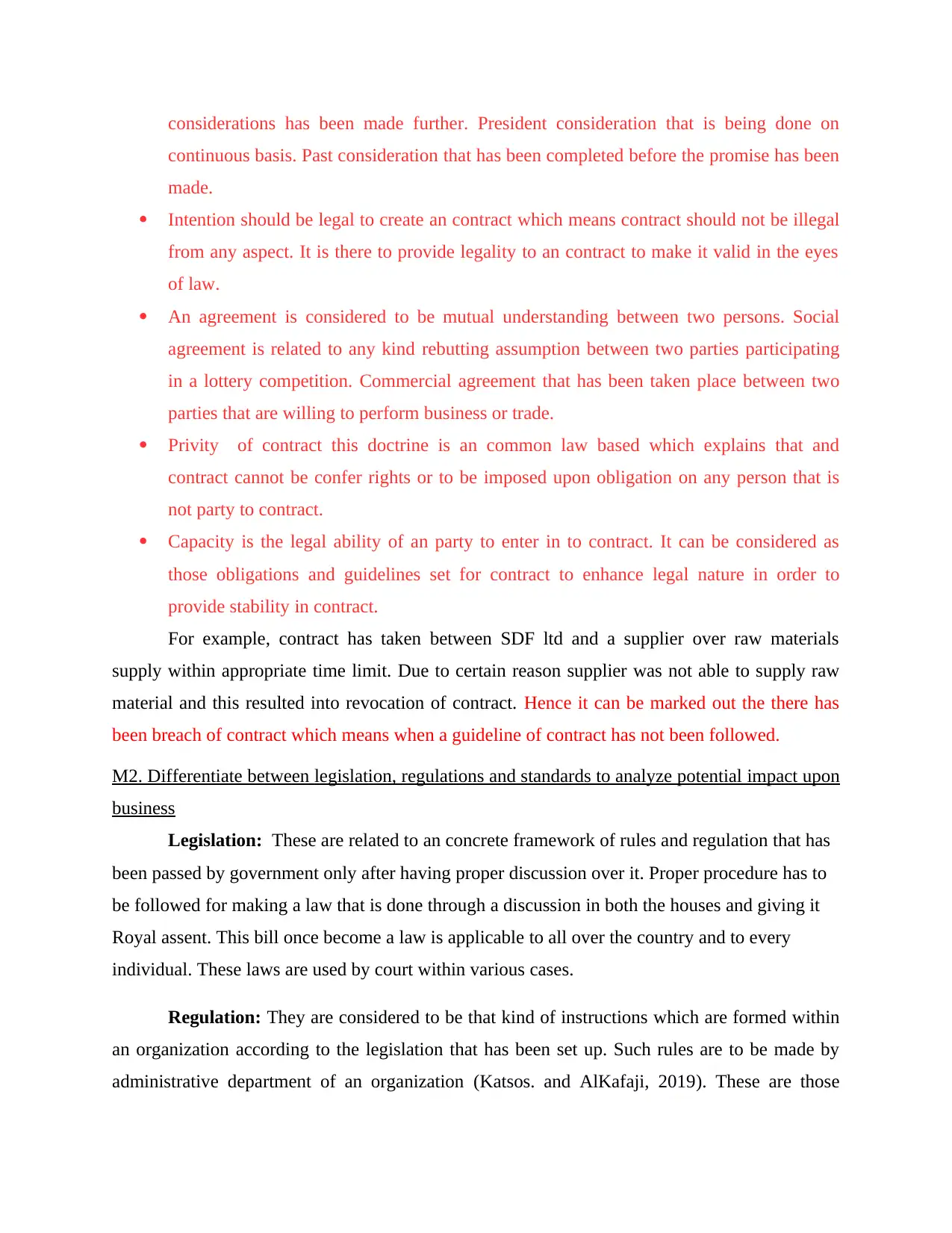
considerations has been made further. President consideration that is being done on
continuous basis. Past consideration that has been completed before the promise has been
made.
Intention should be legal to create an contract which means contract should not be illegal
from any aspect. It is there to provide legality to an contract to make it valid in the eyes
of law.
An agreement is considered to be mutual understanding between two persons. Social
agreement is related to any kind rebutting assumption between two parties participating
in a lottery competition. Commercial agreement that has been taken place between two
parties that are willing to perform business or trade.
Privity of contract this doctrine is an common law based which explains that and
contract cannot be confer rights or to be imposed upon obligation on any person that is
not party to contract.
Capacity is the legal ability of an party to enter in to contract. It can be considered as
those obligations and guidelines set for contract to enhance legal nature in order to
provide stability in contract.
For example, contract has taken between SDF ltd and a supplier over raw materials
supply within appropriate time limit. Due to certain reason supplier was not able to supply raw
material and this resulted into revocation of contract. Hence it can be marked out the there has
been breach of contract which means when a guideline of contract has not been followed.
M2. Differentiate between legislation, regulations and standards to analyze potential impact upon
business
Legislation: These are related to an concrete framework of rules and regulation that has
been passed by government only after having proper discussion over it. Proper procedure has to
be followed for making a law that is done through a discussion in both the houses and giving it
Royal assent. This bill once become a law is applicable to all over the country and to every
individual. These laws are used by court within various cases.
Regulation: They are considered to be that kind of instructions which are formed within
an organization according to the legislation that has been set up. Such rules are to be made by
administrative department of an organization (Katsos. and AlKafaji, 2019). These are those
continuous basis. Past consideration that has been completed before the promise has been
made.
Intention should be legal to create an contract which means contract should not be illegal
from any aspect. It is there to provide legality to an contract to make it valid in the eyes
of law.
An agreement is considered to be mutual understanding between two persons. Social
agreement is related to any kind rebutting assumption between two parties participating
in a lottery competition. Commercial agreement that has been taken place between two
parties that are willing to perform business or trade.
Privity of contract this doctrine is an common law based which explains that and
contract cannot be confer rights or to be imposed upon obligation on any person that is
not party to contract.
Capacity is the legal ability of an party to enter in to contract. It can be considered as
those obligations and guidelines set for contract to enhance legal nature in order to
provide stability in contract.
For example, contract has taken between SDF ltd and a supplier over raw materials
supply within appropriate time limit. Due to certain reason supplier was not able to supply raw
material and this resulted into revocation of contract. Hence it can be marked out the there has
been breach of contract which means when a guideline of contract has not been followed.
M2. Differentiate between legislation, regulations and standards to analyze potential impact upon
business
Legislation: These are related to an concrete framework of rules and regulation that has
been passed by government only after having proper discussion over it. Proper procedure has to
be followed for making a law that is done through a discussion in both the houses and giving it
Royal assent. This bill once become a law is applicable to all over the country and to every
individual. These laws are used by court within various cases.
Regulation: They are considered to be that kind of instructions which are formed within
an organization according to the legislation that has been set up. Such rules are to be made by
administrative department of an organization (Katsos. and AlKafaji, 2019). These are those
⊘ This is a preview!⊘
Do you want full access?
Subscribe today to unlock all pages.

Trusted by 1+ million students worldwide
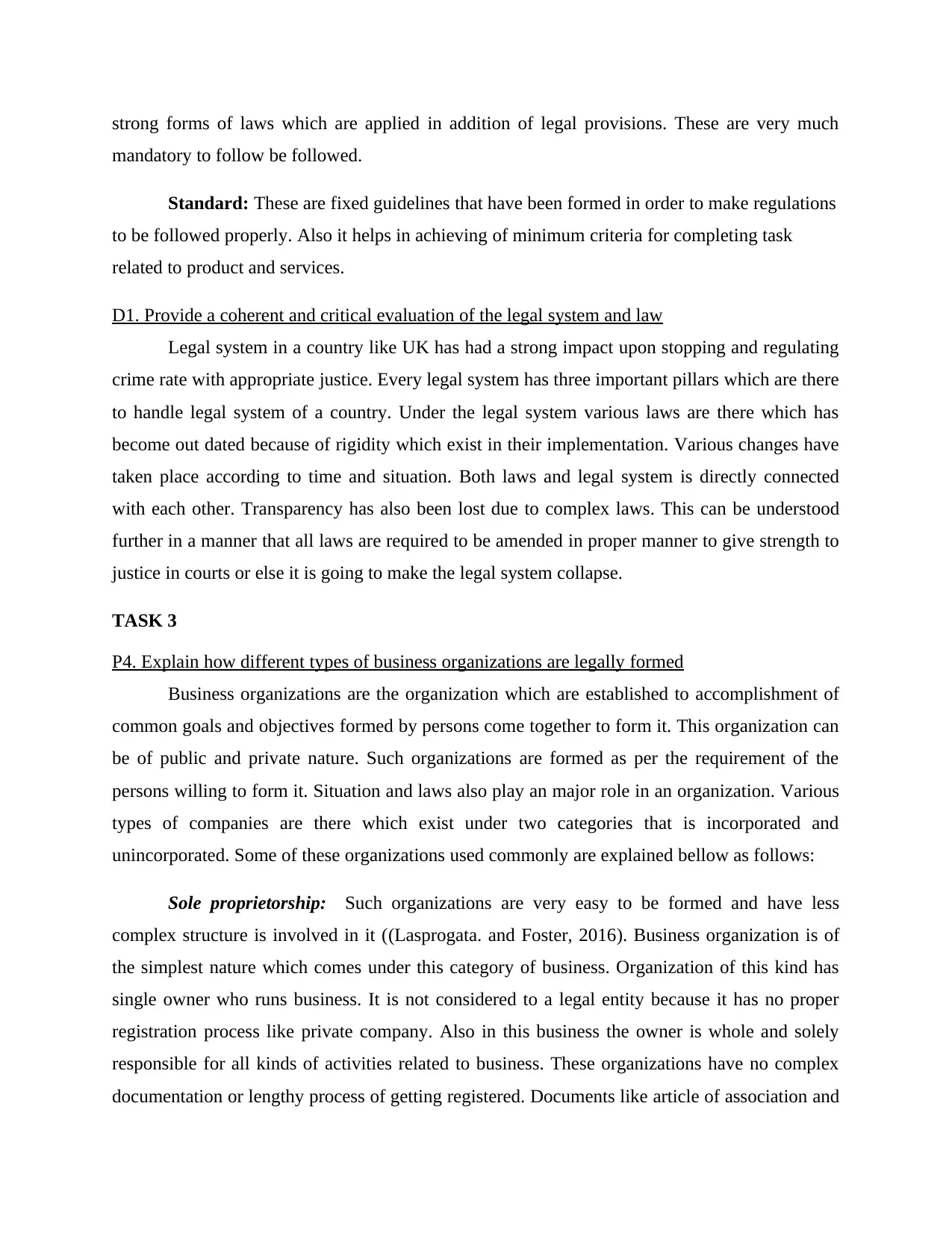
strong forms of laws which are applied in addition of legal provisions. These are very much
mandatory to follow be followed.
Standard: These are fixed guidelines that have been formed in order to make regulations
to be followed properly. Also it helps in achieving of minimum criteria for completing task
related to product and services.
D1. Provide a coherent and critical evaluation of the legal system and law
Legal system in a country like UK has had a strong impact upon stopping and regulating
crime rate with appropriate justice. Every legal system has three important pillars which are there
to handle legal system of a country. Under the legal system various laws are there which has
become out dated because of rigidity which exist in their implementation. Various changes have
taken place according to time and situation. Both laws and legal system is directly connected
with each other. Transparency has also been lost due to complex laws. This can be understood
further in a manner that all laws are required to be amended in proper manner to give strength to
justice in courts or else it is going to make the legal system collapse.
TASK 3
P4. Explain how different types of business organizations are legally formed
Business organizations are the organization which are established to accomplishment of
common goals and objectives formed by persons come together to form it. This organization can
be of public and private nature. Such organizations are formed as per the requirement of the
persons willing to form it. Situation and laws also play an major role in an organization. Various
types of companies are there which exist under two categories that is incorporated and
unincorporated. Some of these organizations used commonly are explained bellow as follows:
Sole proprietorship: Such organizations are very easy to be formed and have less
complex structure is involved in it ((Lasprogata. and Foster, 2016). Business organization is of
the simplest nature which comes under this category of business. Organization of this kind has
single owner who runs business. It is not considered to a legal entity because it has no proper
registration process like private company. Also in this business the owner is whole and solely
responsible for all kinds of activities related to business. These organizations have no complex
documentation or lengthy process of getting registered. Documents like article of association and
mandatory to follow be followed.
Standard: These are fixed guidelines that have been formed in order to make regulations
to be followed properly. Also it helps in achieving of minimum criteria for completing task
related to product and services.
D1. Provide a coherent and critical evaluation of the legal system and law
Legal system in a country like UK has had a strong impact upon stopping and regulating
crime rate with appropriate justice. Every legal system has three important pillars which are there
to handle legal system of a country. Under the legal system various laws are there which has
become out dated because of rigidity which exist in their implementation. Various changes have
taken place according to time and situation. Both laws and legal system is directly connected
with each other. Transparency has also been lost due to complex laws. This can be understood
further in a manner that all laws are required to be amended in proper manner to give strength to
justice in courts or else it is going to make the legal system collapse.
TASK 3
P4. Explain how different types of business organizations are legally formed
Business organizations are the organization which are established to accomplishment of
common goals and objectives formed by persons come together to form it. This organization can
be of public and private nature. Such organizations are formed as per the requirement of the
persons willing to form it. Situation and laws also play an major role in an organization. Various
types of companies are there which exist under two categories that is incorporated and
unincorporated. Some of these organizations used commonly are explained bellow as follows:
Sole proprietorship: Such organizations are very easy to be formed and have less
complex structure is involved in it ((Lasprogata. and Foster, 2016). Business organization is of
the simplest nature which comes under this category of business. Organization of this kind has
single owner who runs business. It is not considered to a legal entity because it has no proper
registration process like private company. Also in this business the owner is whole and solely
responsible for all kinds of activities related to business. These organizations have no complex
documentation or lengthy process of getting registered. Documents like article of association and
Paraphrase This Document
Need a fresh take? Get an instant paraphrase of this document with our AI Paraphraser
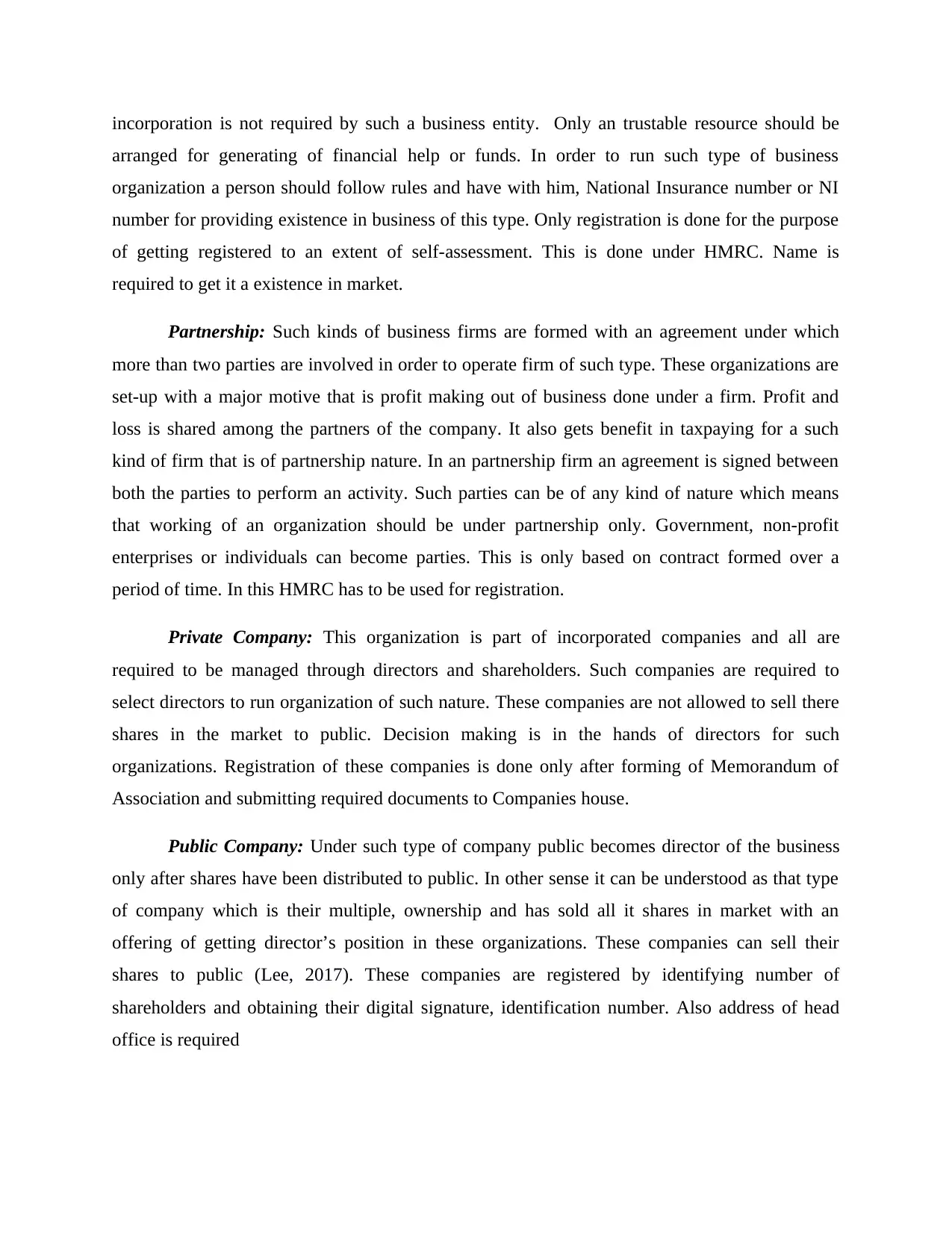
incorporation is not required by such a business entity. Only an trustable resource should be
arranged for generating of financial help or funds. In order to run such type of business
organization a person should follow rules and have with him, National Insurance number or NI
number for providing existence in business of this type. Only registration is done for the purpose
of getting registered to an extent of self-assessment. This is done under HMRC. Name is
required to get it a existence in market.
Partnership: Such kinds of business firms are formed with an agreement under which
more than two parties are involved in order to operate firm of such type. These organizations are
set-up with a major motive that is profit making out of business done under a firm. Profit and
loss is shared among the partners of the company. It also gets benefit in taxpaying for a such
kind of firm that is of partnership nature. In an partnership firm an agreement is signed between
both the parties to perform an activity. Such parties can be of any kind of nature which means
that working of an organization should be under partnership only. Government, non-profit
enterprises or individuals can become parties. This is only based on contract formed over a
period of time. In this HMRC has to be used for registration.
Private Company: This organization is part of incorporated companies and all are
required to be managed through directors and shareholders. Such companies are required to
select directors to run organization of such nature. These companies are not allowed to sell there
shares in the market to public. Decision making is in the hands of directors for such
organizations. Registration of these companies is done only after forming of Memorandum of
Association and submitting required documents to Companies house.
Public Company: Under such type of company public becomes director of the business
only after shares have been distributed to public. In other sense it can be understood as that type
of company which is their multiple, ownership and has sold all it shares in market with an
offering of getting director’s position in these organizations. These companies can sell their
shares to public (Lee, 2017). These companies are registered by identifying number of
shareholders and obtaining their digital signature, identification number. Also address of head
office is required
arranged for generating of financial help or funds. In order to run such type of business
organization a person should follow rules and have with him, National Insurance number or NI
number for providing existence in business of this type. Only registration is done for the purpose
of getting registered to an extent of self-assessment. This is done under HMRC. Name is
required to get it a existence in market.
Partnership: Such kinds of business firms are formed with an agreement under which
more than two parties are involved in order to operate firm of such type. These organizations are
set-up with a major motive that is profit making out of business done under a firm. Profit and
loss is shared among the partners of the company. It also gets benefit in taxpaying for a such
kind of firm that is of partnership nature. In an partnership firm an agreement is signed between
both the parties to perform an activity. Such parties can be of any kind of nature which means
that working of an organization should be under partnership only. Government, non-profit
enterprises or individuals can become parties. This is only based on contract formed over a
period of time. In this HMRC has to be used for registration.
Private Company: This organization is part of incorporated companies and all are
required to be managed through directors and shareholders. Such companies are required to
select directors to run organization of such nature. These companies are not allowed to sell there
shares in the market to public. Decision making is in the hands of directors for such
organizations. Registration of these companies is done only after forming of Memorandum of
Association and submitting required documents to Companies house.
Public Company: Under such type of company public becomes director of the business
only after shares have been distributed to public. In other sense it can be understood as that type
of company which is their multiple, ownership and has sold all it shares in market with an
offering of getting director’s position in these organizations. These companies can sell their
shares to public (Lee, 2017). These companies are registered by identifying number of
shareholders and obtaining their digital signature, identification number. Also address of head
office is required
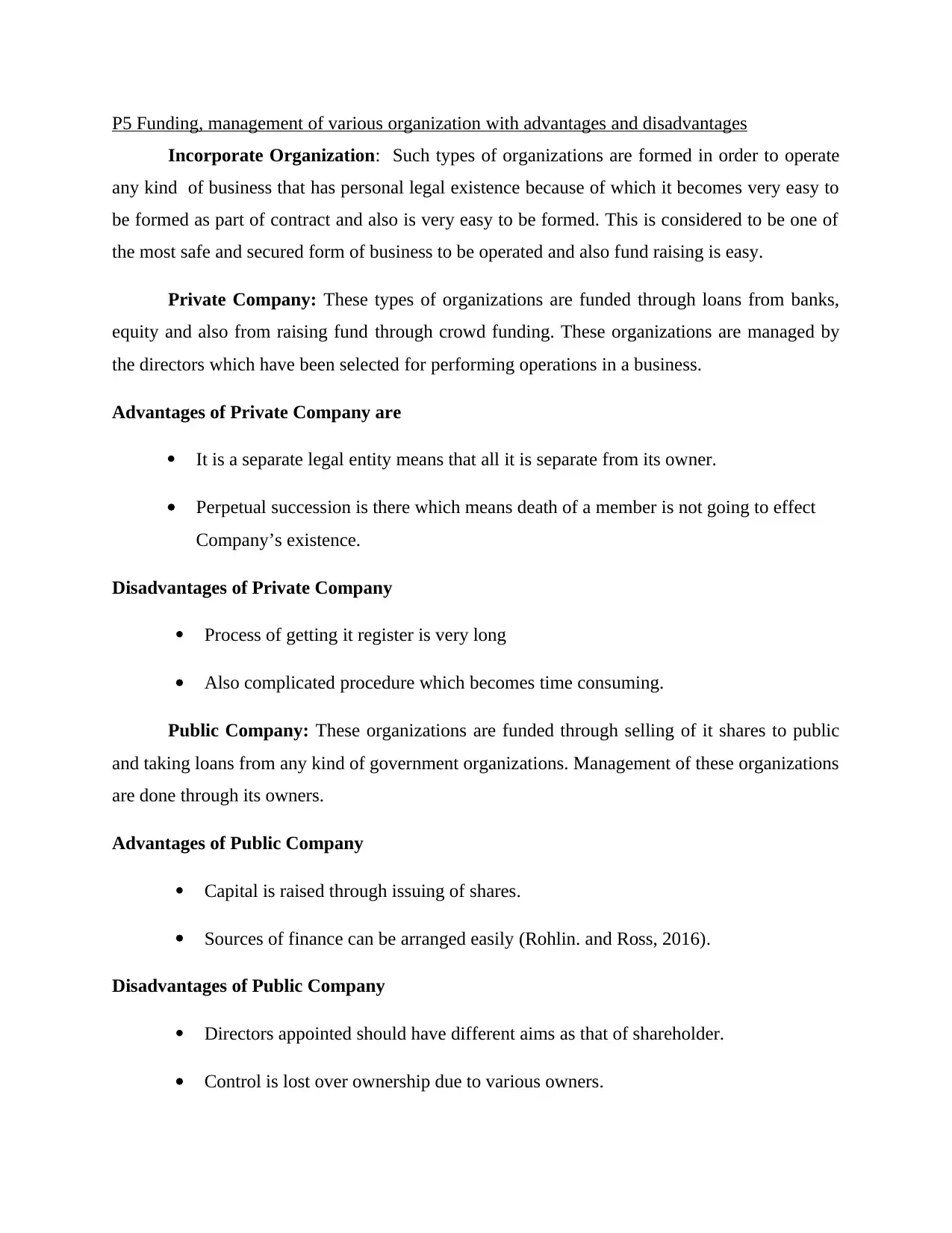
P5 Funding, management of various organization with advantages and disadvantages
Incorporate Organization: Such types of organizations are formed in order to operate
any kind of business that has personal legal existence because of which it becomes very easy to
be formed as part of contract and also is very easy to be formed. This is considered to be one of
the most safe and secured form of business to be operated and also fund raising is easy.
Private Company: These types of organizations are funded through loans from banks,
equity and also from raising fund through crowd funding. These organizations are managed by
the directors which have been selected for performing operations in a business.
Advantages of Private Company are
It is a separate legal entity means that all it is separate from its owner.
Perpetual succession is there which means death of a member is not going to effect
Company’s existence.
Disadvantages of Private Company
Process of getting it register is very long
Also complicated procedure which becomes time consuming.
Public Company: These organizations are funded through selling of it shares to public
and taking loans from any kind of government organizations. Management of these organizations
are done through its owners.
Advantages of Public Company
Capital is raised through issuing of shares.
Sources of finance can be arranged easily (Rohlin. and Ross, 2016).
Disadvantages of Public Company
Directors appointed should have different aims as that of shareholder.
Control is lost over ownership due to various owners.
Incorporate Organization: Such types of organizations are formed in order to operate
any kind of business that has personal legal existence because of which it becomes very easy to
be formed as part of contract and also is very easy to be formed. This is considered to be one of
the most safe and secured form of business to be operated and also fund raising is easy.
Private Company: These types of organizations are funded through loans from banks,
equity and also from raising fund through crowd funding. These organizations are managed by
the directors which have been selected for performing operations in a business.
Advantages of Private Company are
It is a separate legal entity means that all it is separate from its owner.
Perpetual succession is there which means death of a member is not going to effect
Company’s existence.
Disadvantages of Private Company
Process of getting it register is very long
Also complicated procedure which becomes time consuming.
Public Company: These organizations are funded through selling of it shares to public
and taking loans from any kind of government organizations. Management of these organizations
are done through its owners.
Advantages of Public Company
Capital is raised through issuing of shares.
Sources of finance can be arranged easily (Rohlin. and Ross, 2016).
Disadvantages of Public Company
Directors appointed should have different aims as that of shareholder.
Control is lost over ownership due to various owners.
⊘ This is a preview!⊘
Do you want full access?
Subscribe today to unlock all pages.

Trusted by 1+ million students worldwide
1 out of 20
Related Documents
Your All-in-One AI-Powered Toolkit for Academic Success.
+13062052269
info@desklib.com
Available 24*7 on WhatsApp / Email
![[object Object]](/_next/static/media/star-bottom.7253800d.svg)
Unlock your academic potential
Copyright © 2020–2025 A2Z Services. All Rights Reserved. Developed and managed by ZUCOL.





